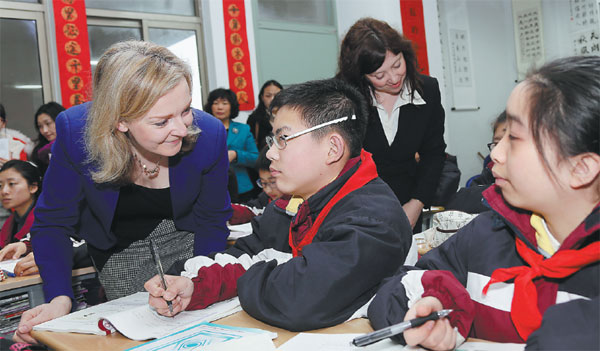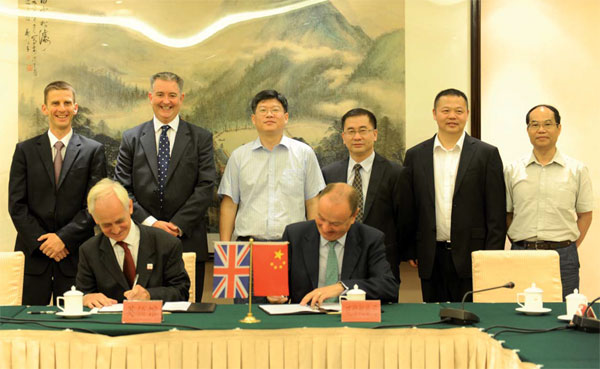Carbon emissions targeted by British-Chinese joint efforts
Updated: 2015-08-14 08:58
By Cecily Liu(China Daily Europe)
|
|||||||||||
UK expertise can help areas like renewable energy and green building technology
Britain's carbon reduction knowledge and expertise can greatly help China to reduce its carbon emissions, especially in areas like renewable energy and green building technology, says Jan Van der Ven, Asia director of The Carbon Trust.
The Carbon Trust, which the British government founded in 2001 as a charity to help government and businesses implement energy saving measures, set up a representative office in China in 2009, the first international market it ventured into.
|
An offshore wind partnership signed between China and the UK. Provided to China Daily |
"As a government-supported organization with the goal to reduce carbon emissions, we've successfully completed many projects in the UK, and then we looked at how can we share these internationally in order to accelerate sustainable development," says Van der Ven.
"We looked at China, which is the world's largest emitter of carbon emissions, so we decided to set up in China and share some of the UK's experience with China," he says.
Through several years of work in China, The Carbon Trust has established partnerships with many local governments and industry groups, supporting and advising them to implement carbon reduction schemes.
One example is a product carbon footprint labeling scheme, which The Carbon Trust has helped the China Manufacturers' Association in Hong Kong set up. Started in 2013, the scheme may be implemented later this year.
Meanwhile, it is also advising the China Quality and Certification Center in Guangzhou to establish a similar product-footprint labeling scheme for companies in Guangzhou, which started in March and which is intended to be completed next year.
The scheme will help companies label the carbon footprint of their products, so that in the long term, consumers could take into account the environmental impact of a product as a part of their purchasing decision, alongside other factors like cost and quality.
But before enough companies sign up to make the comparison possible, those that take the initiative to label their products' carbon footprint will be recognized by consumers as having a socially responsible attitude. "It will have marketing and image benefits for the companies," says Van der Ven.
The Carbon Trust's input in setting up these plans focuses on helping partner organizations create rules for the schemes, he says. It is also able to integrate the plans with a similar labeling scheme in the United Kingdom.
This would make comparison possible, although it would be subject to agreements between different local and national authorities.
The Carbon Trust is also working with the Hunan Low Carbon Center to identify technology from British companies which would help industrial companies in Hunan province reduce emissions.
The two organizations will identify potential emission reduction solutions for Hunan companies by March 2016, and then look at the possibility of introducing companies with expertise to those who need it.
Meanwhile, the UK organization is also working with China's Energy Research Institute to identify market-orientated energy efficiency mechanisms for key energy intensive enterprises. The Carbon Trust has already shared some of its recommendations with ERI, based on its experiences in the UK market.
Van der Ven says often these policies require the government to introduce market incentives, otherwise, it would be difficult for private sector to take the initiate.
Since starting to operate in China, The Carbon Trust has participated in some initiatives that have already produced results. A survey conducted in China in 2012 showed young consumers are global leaders in calling for carbon reductions, and consumer demand is a key driver for business directions.
In the survey, 83 percent of Chinese respondents said they would be more loyal to a brand if they could see it was reducing its carbon emissions, compared with 77 percent in Brazil, 76 percent in South Africa, 73 percent in South Korea, 57 percent in the United States and 55 percent in Britain.
About 500 people aged 18-25 were interviewed online in each country. Most respondents from China were from urban areas, given their better Internet access.
Sixty percent of Chinese respondents said they would stop buying a product if its manufacturer refused to commit to measuring and reducing its carbon footprint, followed by 57 percent in Brazil, 53 percent in South Korea, 51 percent in South Africa, 36 percent in Britain and 35 percent in the US.
Eighty-four percent of Chinese respondents also said they want to see companies' carbon impact quantified by an independent organization, followed by 77 percent in South Africa, 73 percent in Brazil, 69 percent in South Korea, 56 percent in Britain and 55 percent in the US.
Another example of The Carbon Trust's previous efforts in China is a research project into China's offshore wind industry, which generated recommendations on how China can further grow this sector.
The research was completed in 2013 with recommendations, which The Carbon Trust presented to its Chinese partners, and Van der Ven says that he hopes some of these policy recommendations will be adopted by the Chinese government in its 13th Five-Year Plan when it is launched in 2016.
Funded by the UK Foreign Office, the project was carried out partly because The Carbon Trust has demonstrated great expertise in offshore wind energy by contributing to the work of the Offshore Wind Accelerator, a joint industry research project started in 2008 that aims to help Britain's offshore wind industry cut costs by at least 10 percent by 2015.
In Britain, the Offshore Wind Accelerator enabled nine international offshore wind developers to fund research work, reducing the risks of commercialized innovative technologies and enabling sharing. It was two-thirds funded by industry and one third funded by the UK Department of Energy and Climate Change.
The Carbon Trust's research in China was done with the participation of over 20 Chinese companies and has drawn up some recommendations for China to consider.
They include the development of an effective, publicly funded research and demonstration program to commercialize new cost-reducing innovations, and the development of an offshore wind capital grants scheme to improve the government's awareness of the commercial realities of developing offshore wind plants in Chinese waters, with R&D and technology testing.
In addition, China could set up an effective continuous price support mechanism to balance developer incentives with government costs to ensure value for money for electricity consumers and taxpayers. As well, it could develop an effective zoning policy to accelerate planning by relaxing constraints in identified development zones.
Many barriers face the Chinese offshore wind industry, including uncertainty over an effective and efficient long-term pricing policy that is needed by project developers while ensuring consumers are protected from high costs. Other challenges include authorities that are slow in giving consent and the lack of a focused innovation program to reduce costs of the deployment process, the research discovered.
Van der Ven says that over the long term, the key to reducing carbon emissions in China will be a fundamental shift from fossil fuel as a major part of energy consumption towardsrenewable sources.
"The big emitters in China are the heavy industries, like steel, cement, and chemical industries, and their reliance is on coal, so to change the energy supply fundamentally will allow China to reduce carbon emissions," Van der Ven says. In addition, addressing high emissions from buildings by introducing green building technology will also greatly aid China, and Van der Ven says his team is now exploring Britain's expertise to see if it can help.
cecily.liu@chinadaily.com.cn
( China Daily European Weekly 08/14/2015 page23)
Today's Top News
Turkey's early elections 'decidedly possible': PM
Death toll rises to 50, military sends chemical specialists to blast site
12 firefighters among 44 killed in explosions
Chinese yuan extends fall Thursday
China rattles a few cages in the world's financial markets
Tibetan drivers to finally see the end of 'death road'
China becomes world's largest robots market for second consecutive year
Yuan may stumble, but will not fall
Hot Topics
Lunar probe , China growth forecasts, Emission rules get tougher, China seen through 'colored lens', International board,
Editor's Picks

|

|

|

|

|

|







